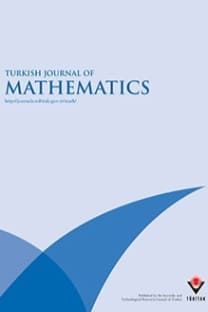Construction of minimal linear codes with few weights from weakly regular plateaued functions
Construction of minimal linear codes with few weights from weakly regular plateaued functions
___
- [1] Ashikhmin A, Barg A. Minimal vectors in linear codes. IEEE Transactions on Information Theory 1998; 44 (5): 2010-2017.
- [2] Bosma W, Cannon J, Playoust C. The Magma algebra system I: The user language Journal of Symbolic Computation 1997; 24 (3): 235-265.
- [3] Calderbank A, Goethals J. Three-weight codes and association schemes. Philips Journal of Research 1984; 39 (4-5): 143-152.
- [4] Carlet C, Ding C, Yuan J. Linear codes from perfect nonlinear mappings and their secret sharing schemes. IEEE Transactions on Information Theory 2005; 51 (6): 2089-2102.
- [5] Çeşmelioğlu A, Meidl W. A construction of bent functions from plateaued functions. Designs, Codes and Cryptography 2013; 66 (1): 231-242.
- [6] Cheng Y, Cao X. Linear codes with few weights from weakly regular plateaued functions. Discrete Mathematics 2021; 344 (12): 112597.
- [7] Ding, C. Linear codes from some 2-designs. IEEE Transactions on Information Theory 2015; 61 (6): 3265-3275.
- [8] Ding C. A construction of binary linear codes from Boolean functions. Discrete mathematics 2016; 339 (9): 2288- 2303.
- [9] Ding C, Niederreiter H. Cyclotomic Linear Codes of Order 3. IEEE Transactions on Information Theory 2007; 53 (6): 2274-2277.
- [10] Ding C, Yuan J. Covering and secret sharing with linear codes. In: International Conference on Discrete Mathematics and Theoretical Computer Science (DMTCS); Dijon, France; 2003. pp. 11-25.
- [11] Ding K, Ding C. Binary linear codes with three weights. IEEE Communications Letters 2014; 18 (11): 1879-1882.
- [12] Ding K, Ding C. A class of two-weight and three-weight codes and their applications in secret sharing. IEEE Transactions on Information Theory 2015; 61 (11): 5835-5842.
- [13] Grassl M. Bounds on the minimum distance of linear codes and quantum codes. www.codetables.de (2019), Accessed April 2021.
- [14] Jian G, Lin Z, Feng R. Two-weight and three-weight linear codes based on Weil sums. Finite Fields and Their Applications 2019; 57: 92-107.
- [15] Kumar P, Scholtz R, Welch L. Generalized bent functions and their properties. Journal of Combinatorial Theory Series A 1985; 40 (1): 90-107.
- [16] Li C, Li N, Helleseth T, Ding C. The weight distributions of several classes of cyclic codes from APN monomials. IEEE Transactions on Information Theory 2014; 60 (8): 4710-4721.
- [17] Li C, Yue Q, Fu FW. A construction of several classes of two-weight and three-weight linear codes. Applicable Algebra in Engineering, Communication and Computing 2017; 28 (1): 11-30.
- [18] Li N, Mesnager S. Recent results and problems on constructions of linear codes from cryptographic functions. Cryptography and Communications 2020; 12: 965-986.
- [19] Lidl R, Niederreiter H. Finite fields. 2nd Edition. Cambridge, UK: Cambridge University Press, 1997.
- [20] Mesnager S. Linear codes from functions. In: Huffman WC, Kim JL, Solé P (editors). A Concise Encyclopedia of Coding Theory 2021. Chapman and Hall/CRC Press Taylor and Francis Group, London, New York 2021, pp. 463-526.
- [21] Mesnager S. Linear codes with few weights from weakly regular bent functions based on a generic construction. Cryptography and Communications 2017; 9 (1): 71-84.
- [22] Mesnager S, Özbudak F, Sınak A. Linear codes from weakly regular plateaued functions and their secret sharing schemes. Designs, Codes and Cryptography 2019; 87 (2-3): 463-480.
- [23] Mesnager S, Sınak A. Several Classes of Minimal Linear Codes With Few Weights From Weakly Regular Plateaued Functions. IEEE Transactions on Information Theory 2020; 66 (4): 2296-2310.
- [24] Rothaus, O. On “bent” functions. Journal of Combinatorial Theory Series A 1976; 20 (3): 300-305.
- [25] Sınak A. Minimal linear codes from weakly regular plateaued balanced functions. Discrete Mathematics 2021; 344 (3): 112215.
- [26] Tang C, Li N, Qi Y, Zhou Z, Helleseth T. Linear codes with two or three weights from weakly regular bent functions. IEEE Transactions on Information Theory 2016; 62 (3): 1166-1176.
- [27] Tang C, Xiang C, Feng K. Linear codes with few weights from inhomogeneous quadratic functions. Designs, Codes and Cryptography 2017; 83 (3): 691-714.
- [28] Wu Y, Li N, Zeng X. Linear codes with few weights from cyclotomic classes and weakly regular bent functions. Designs, Codes and Cryptography 2020; 88: 1255-1272.
- [29] Zeng X, Shan J, Hu L. A triple-error-correcting cyclic code from the Gold and Kasami–Welch APN power functions. Finite Fields and Their Applications 2012; 18 (1): 70-92.
- [30] Zheng Y, Zhang XM. On plateaued functions. IEEE Transactions on Information Theory 2001; 47 (3): 1215-1223.
- [31] Zhou Z, Li N, Fan C, Helleseth T. Linear codes with two or three weights from quadratic bent functions. Designs, Codes and Cryptography 2016; 81 (2): 283–295.
- ISSN: 1300-0098
- Yayın Aralığı: 6
- Yayıncı: TÜBİTAK
Ricci-Yamabe solitons and 3-dimensional Riemannian manifolds
Uday Chand DE, Arpan SARDAR, Krishnendu DE
Second main theorem for meromorphic mappings intersecting moving targets on parabolic manifolds
Relation between matrices and the suborbital graphs by the special number sequences
Ümmügülsün AKBABA, Ali Hikmet DEĞER
Existence and transportation inequalities for fractional stochastic differential equations
Abdelghani OUAHAB, Mustapha BELABBAS, Johnny HENDERSON, Fethi SOUNA
Composition laws on the Fricke surface and Markov triples
Esra Ünal YILMAZ, Abdurrahman Muhammed ULUDAĞ
Application of Gegenbauer polynomials for biunivalent functions defined by subordination
Saqib HUSSAIN, Ibrar AHMAD, Fethiye Müge SAKAR
Yige ZHAO, Yibing SUN, Qiangqiang XIE
Berezin symbol inequalities via Grüss type inequalities and related questions
Mübarız GARAYEV, Ramiz TAPDIGOĞLU, Najla ALTWAIJRY
On extended interpolative single and multivalued F -contractions
Metric connection on tangent bundle with Berger-type deformed Sasaki metric
